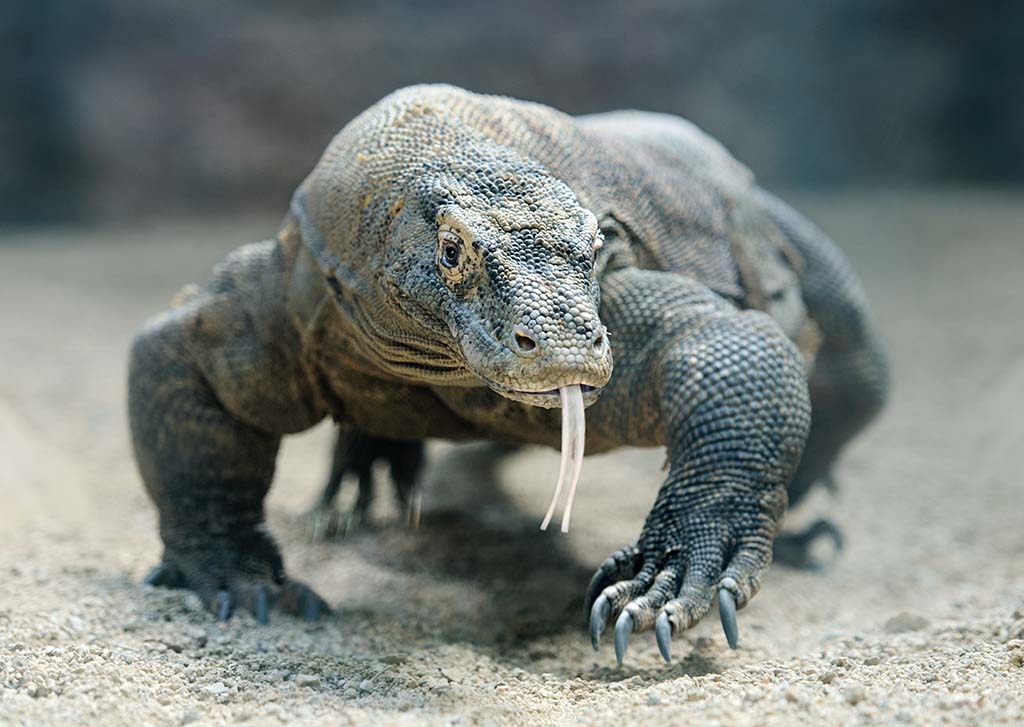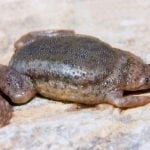Scientific Facts
| Common Name: | Komodo dragon, Komodo monitor |
| Scientific Name: | Varanus komodoensis |
| Life Span: | Up to 30 years |
| Size: | 6 to 10 feet |
| Habitat: | Tropical savanna forests |
| Country of Origin: | Specific Indonesian islands |
Overview
Varanus komodoensis, or the Komodo Dragon or Komodo Monitor, is the largest extant lizard on Earth. It is endemic to some small islands found in Indonesia. Varanus, its genus name, is a Latin word for the Arabic word waran that means monitor. Meanwhile, the word Komodo is just one of the islands where they can be found.
The V. komodoensis has a common ancestor with dinosaurs; however, they don’t descend from them. Instead, they belong to Diapsida, a subclass. There are debates regarding how komodo dragons grow as they are, although they live isolated on the island that has limited food.
In 1910, the Komodo dragon was documented first by Lieutenant Van Hensbroek. He went to Komodo Island when he heard about this giant lizard. He killed one, got skin, and send some photos to the director of the Zoological Museum in Java. The director identified it as a monitor lizard. In a certain year, this resulted in expeditions where they got 27 specimens and examined 70 more.
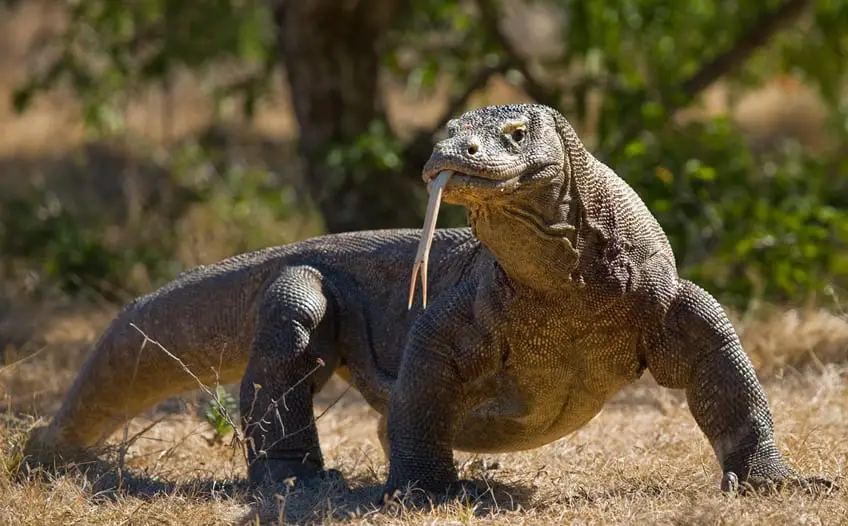
Physical Description
They are the largest existing lizard having a length of 2.6 meters and 40 to 70 kilograms. These dragons have curved and sharp claws. The curved is about 60 and serrated teeth having 4 to 5 replacement teeth for each position. The teeth serration is a tool for them to tear their large prey into smaller bites. When the meat is stuck between their teeth, it can get decayed and lead to the growth of a lot of septic bacteria. This bacterium leads to their prey’s death and will serve as the Komodo dragon’s meal. Komodo monitors have resistance to bacteria. That is why, despite being bitten by another dragon, no infection will occur in their bodies.
They are also known for having sturdy limbs, long tails, agile, and strong necks. Their tongues are forked and yellow. Adults have got stone color having large and distinct scales. Meanwhile, juveniles have more vibrancy in color and pattern. Both sexes are similar in color, but females are redder on the flanks.
Their muscles in the jaw and throat let them swallow big meat chunks quickly. The intramandibular, a movable joint opens the jaw widely. Then, the stomach expands, letting them eat around 80 percent of their body weight in just one meal. This is seen as the reason why they grow so big. When faced with threats, they tend to throw up what they have eaten in order to run away.
Males are larger and bulkier than the females. There are no evident morphological differences. A subtle difference is the scales’ arrangement in front of the cloaca. They detect their food as far as five kilometers away. The scent particles taken by the air are gathered by their forked tongue and taken to their roof’s mouth where the signals are sent to their brain. Their retinas have cone cells that detect color, but their vision gets weak in the dim light. It is useful for motion hunting. They are not deaf. They don’t rely on sound. They can hear some range of frequencies.
Size
They weigh 70 kilograms with a length of 10.3 feet. The largest recorded is 166 kilograms.
Native Habitat
Komodo dragons are limited to a few islands in Indonesia like Lesser Sunda, Rintja, Flores and Padar, and finally, the Komodo Island. It is the largest island having 35 kilometers long.
The habitat for them is the tropical savanna forest and rocky hills. The adults choose open areas having tall grass of bushes and trees. The hatchlings and juveniles like the more forested areas. It is where the loft and stay away from any predators.

Food and Eating Habits
They eat any kind of meat that ranges in size from small rodents to big water buffalo. The young ones are fed on insects, small lizards, birds, and snakes. At 5 years old, they eat larger prey like monkeys, goats, deer, wild boards, and more. These dragons are at the top of the food chain.
The speed of Komodo Dragons is 16 to 20 kilometers per hour. They hunt using their power and stealth. They spend some hours in a spot waiting for prey to cross before they start to attack. Their attempts are often not successful, but if they bite their prey dies due to venom and bacteria in their saliva. When the prey dies, the Komodo finds the dead body by tracing the smell. Komodo dragons share the kill between them.
Again, they can see their prey at 300 meters; thus, their vision has a big role when hunting. Their eyes are good at detecting movements. Their retinas can distinguish color but get poor in dim light. Their hearing range is much smaller than humans. Therefore, they can’t hear a low voice or high screams.
The sense of smell of Komodo Dragons is their main way to detect food. They use their forked and yellow tongue to smell. They move the tip of their tongue until the mouth’s roof and contacts the Jacobson organ. The chemicals analyze the smell of their prey. If the molecule’s concentration is greater on the left tip, then they know it is a deer that is coming from the left. This way and their undulatory walk plus swinging of head from each side that helps them find the direction of the food. Most of the time, they smell rotting flesh u to 4 kilometers away.
Their serrated, large and curved teeth are the Komodo Dragons’ deadliest weapon. They use it to tear meat. Their teeth hold some bits of meat from a previous meal, and that residue contains a lot of bacteria up to 50. Seven of which are so septic. There is also a venom in their jaw. The venom causes shock and blood loss of the prey.
The bite of Komodo Dragons can be lethal but not to them or other dragons. There might be antibodies in them that prevents them from getting unaffected when they do sparring. They are efficient eaters. They leave just 12 % of their prey. They eat hooves, bones, intestines, and more. they consume fish and beef occasionally.
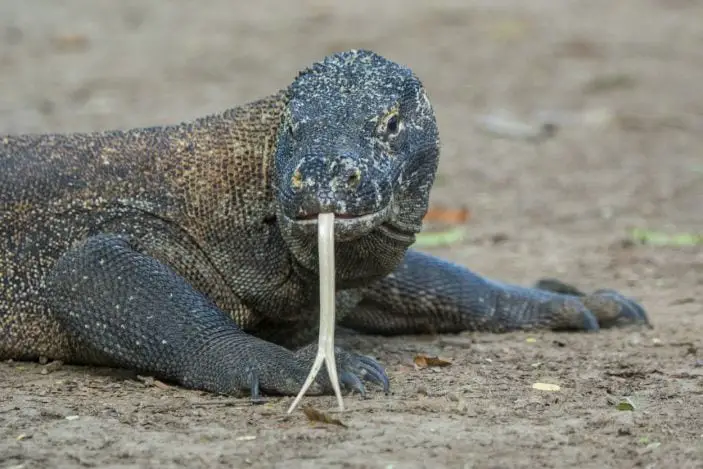
Life Span of Komodo Dragons
They live up to 30 years in the wild and 25 years in captivity. Studies are still being one about it.
Reproduction and Development
Again, determining their sex is still a challenge. No morphological difference except the scales arrangement in their cloaca. Their mating starts from May to August. The strong males compete in ritual combats. They use their tail as a support. They do wrestling in upright positions and grab each other using their forelegs and attempt to throw the other male to the ground. Their fight is a little bloody. The loser runs or remains motionless.
The females lay about thirty eggs in dug found on slopes of the hill or nests of megapodes. Their nest is three feet in height and three meters across. Egg laying is sometimes delayed. This way, the clutch doesn’t suffer from hot months in summer. In addition, the unfertilized eggs get another chance for another mating. The incubation takes nine months. mothers don’t care for their newly hatch.
When hatched, they weigh 100 grams or less and is 40 centimeters long. At their young age, they fall to predators like other Komodo. At five, they are now 25 kilograms and two meters long. This time, they start hunting bigger prey, and their growth continues.
Behavior
Komodo monitors are ectotherms. To protect themselves from the heat, they dig dens. Digging is done to find rodents, snakes, or other foods. In digging, they use their forelegs. The legs are used alternately.
The young dragons have rubbing behavior. It is done by rubbing their bodies in the hair or to the intestinal contents of the carrion. They cover themselves in feces as a way to protect themselves from predators.
Feeding
They are predators and scavengers. The hatchlings are feed on insects only. The small to medium-sized Komodos eat eggs, birds, rodents, and smaller lizards, whereas the bigger ones hunt or eat carrion. They don’t chase their prey. They are patient waiting instead. Smaller preys are eaten whole, while big ones are sliced then devoured. Ingestion rate is 2.5 kilograms per minute, and digestion efficiency is 70 to 90 %.
Locomotion
They are quadrupedal. They walk at about 4.8 kilometers per hour and runs for 14 to 20 kilometers per hour on short distances. Their tail, body, and head move side to side, but when running, their hind feet move in a lateral arc, and their tail is held from the ground. In the water, they are strong swimmers. The young are good climbers, but it gradually disappears as they get heavier and older.
Communication
They like being alone; thus, they come together occasionally for reproduction or around the carrion. They show minimal territorial behavior. The dominance among them is based on their size and sex.
There are no sexual displays; however, there are aggregates for establishing hierarchy and mating. When threatened, they show hissing, mouth gaping, tail lashing, and arched back. Hissing is their defensive behavior when feeding or attacks. Additionally, it is used by the females when they mate. Deaths and cuts happen in males’ fighting.
In Captivity
Komodo Dragons are sought for zoo attractions because of their reputation and size. However, they are rare in zoos as they are susceptible to parasitic disease and infection and aren’t ready to reproduce when in captivity. The first dragons were displayed in London. More exhibitions were done, but they lived short. Nonetheless, there are some groups that do captive breeding.
Those specimens in captivity were tamed in a short time and can recognize humans and discriminate unfamiliar and familiar keepers and engages in play with various objects. In contrast, they get aggressive when there is a territory invasion by an unfamiliar individual. Some people were bitten and injured by Komodo dragons.
Conservation
Komodo dragons are classified as a vulnerable species by the IUCN Red List. There are threats caused by humans. Komodo National Park was established in 1980 to protect these reptiles. Generally, Komodo monitors avoid human encounters. The young are shy and runs away when cornered by a human, but older ones retreat at a shorter distance. They gape, hiss, and swing tail if cornered. When threatening is more serious, they attack and bite.
Environmental reasons like earthquakes, volcanic activity, and loss of habitat as well as human actions like tourism, fire, illegal trade, and poaching are contributors to the status of these dragons.
Interesting Facts
- The saliva from the Komodo dragon is red and has 50 infectious bacteria.
- These dragons don’t breathe and run at the same time. For that reason, they have a pouch under their chin. It has air used while chasing prey.
- They throw up their stomach’s content to flee quickly.
- They have 60 sharp and short teeth.
- They can do virgin birth. It means they can reproduce without a male. This is because of parthenogenesis.
- They are so old. They have evolved from a giant monitor lizard in Australia many years ago and became isolated.
Availability: Where to Get One?
Unfortunately, you cannot raise a Komodo Dragon in captivity. They are listed as an endangered species. It is protected internationally. Only the zoos can them. A water monitor lizard would be a substitute.
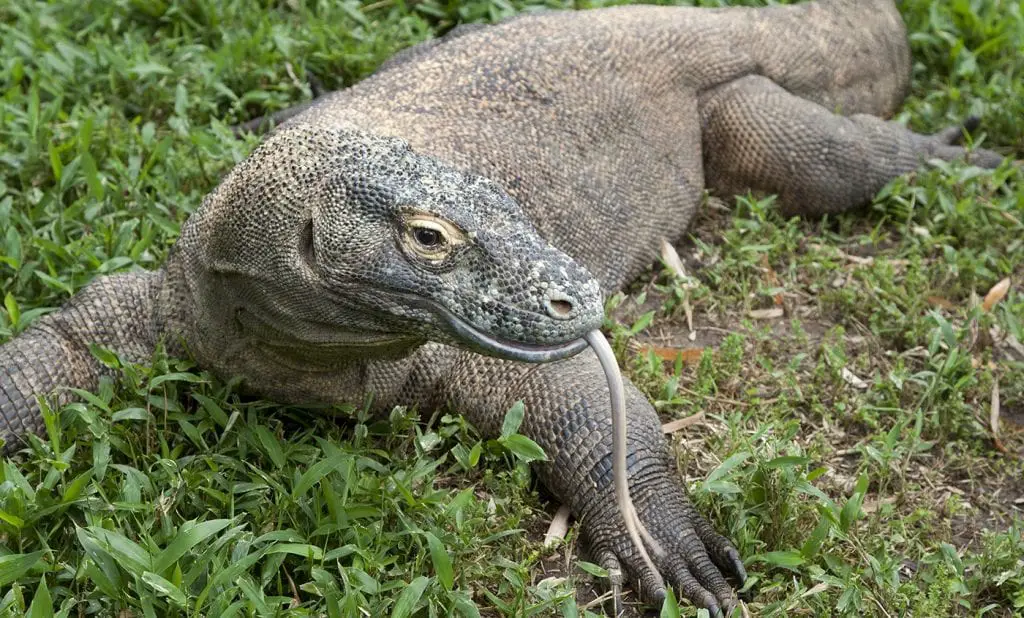
How to Care
Housing
- Always go with the largest size of the cage. It should be 8′ x 3′ x 6′. You can use 2 x 4s with plywood and mesh. The sides can be wired, and the 3 sides would be from plywood, and the front would be a wire mesh door. Having a cage that 3 solid walls will keep the temperature.
- Put the cage in a room having a consistent temperature to avoid extreme cold or heat. Don’t put it near the window, heaters, or air conditioner.
- Put ramps, branches, shelves, and others for basking, climbing, and exploring and a hidden area for them to feel secure and safe.
- Put a large tube for soaking.
Food & Supplements
Give them crickets, mealworms, grasshoppers and cockroaches, or pre-killed mice. Feed them with appropriate size. Offer them supplements for nutrients and vitamins like calcium and vitamin D3.
Heat and lighting
A water heater will be needed and a long UVB fluorescent bulb to light the area for 12 hours. Put light fixtures for them not to get near to the source of heat and light. Put a basking bulb to keep them warm. Put thermometer for monitoring. They need heat to stay healthy. 80 degrees F is good for their habitat, and basking area should be 100 degrees F. to regulate heat 75 degrees F is needed.
Substrate
Consider putting a deep substrate. Use sand and clean dirt or eco-earth. You can buy from pet stores. It is easy to clean and scoop the waste out of it. Tile or vinyl flooring is good too.
There should be water and food bowls to avoid spillage
Cleaning
Clean your water and food bowl every day with soap and warm water. empty your pools as there might be a waste of your pets there. Include cleaning the ramps, ledges, branches and etc. remove waste daily.
Health and Illness
Your Komodo lizards can live long if you give them proper care, habitat, food, and so on. However, some diseases can arise.
Burns
They can get burned when they get too near the source of heat or light. Treat minor burns with soap and water or antiseptic ointment. Locate the source of heat and light away from their reach.
Calcium & Vitamin D3 Deficiency
This is caused by a lack of vitamin D3 and calcium, as well as proper UVB lighting and too much phosphorus in their diet. Symptoms are weight loss, swollen limbs, lethargy, and more. Give them proper lighting, supplement, and correct food, as well as vitamin D3 and calcium.
Calcium Over-Supplementation
This is too much supplementation of calcium and vitamin D3. It can lead to excessive calcium in the blood and hypercalcemia. Give the supplement in moderation. A pinch of vitamin D3 and calcium a couple of times in a week.
Constipation
They don’t excrete their waste regularly. This is affected by temperature. At excessive temperature, your pet may not pass waste frequently and can have indigestion. Keep their home temperature appropriately.
Blockage can be caused by eating some objects in the cage or substrate. Prepare water for hydrating your pet.
Infections
They are vulnerable to infections. Those who are stressed or have unclean habitat tend to get sick. They show swelling, abscess, loss of appetite, and discoloration. Keep their homes clean, and don’t give them stress.
Injuries
Treat small injury with antiseptic and soapy water. If it doesn’t get well, you can take it to a vet for treatment. Injuries and broken bones can be a result of improper handling and accident.
Respiratory Infection
The signs and symptoms of a respiratory infection include lethargy, sneezing, and shallow or rapid breathing. A respiratory infection occurs if the habitat of the Komodo Dragon is too damp or too cold. With proper temperature and habitat, you’ll keep your Komodo Dragon healthy. Another reason is parasites like roundworms. Take them to the veterinarian for treatment and maintain a clean home for your dragon.
Shedding
It is normal for them to shed for sometimes it gets stuck, so prepare water or give a warm bath.
Tail
They may injure or break their tail. It will not regenerate.
Toes & Claws
From normal activities, they may still get injured. Trim their nails with nail clippers. Don’t cut too deep so as not to hurt the reptile.
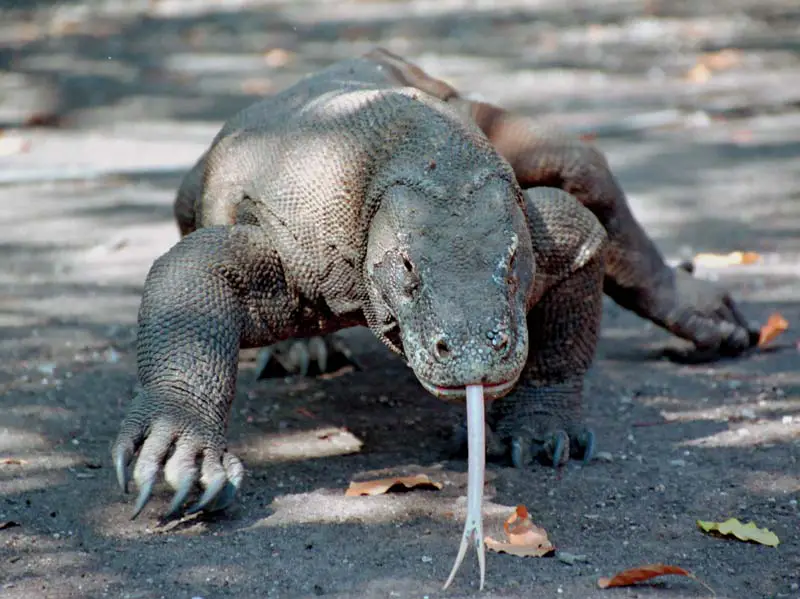
FAQ Section
Do Komodo dragons eat people?
There are occasional attacks of the Komodo dragon to humans. They eat deer and carrion.
Where do the Komodo dragons live?
They live on the islands of Indonesia. They are Rinca, Gili Dasami, Gili, Komodo, and Flores. These islands are volcanic, hilly, and rugged, having savanna grassland and forest.
How many Komodo dragons are left?
In the wild, there are about 6,000 left. It is separated as follows: 1,700 on Komodo, 100 on Gili Motang, 1,300 on Rinca, and around 2,000 on Flores.
Do Komodo dragons make good pets?
Unfortunately, you cannot have them as pets. It is illegal to keep them. They are protected and cited as endangered species.
Can a Komodo dragon kill you?
There are rare attacks of the Komodo dragon to humans, but it has increased. They have shark-like teeth and venom that can kill a person.
Can Komodo dragons climb?
The baby dragons tend to be eaten by adults, so they spend their early life in trees. They are good climbers, but when they get old, they hardly climb trees.
Are Komodo dragons still alive?
Yes, they are. However, they may not survive. These lizards are on the red list of IUCN. These days, not so many Komodo dragons live on the home island.
Do Komodo dragons lay eggs?
Yes, they do. They produce asexually or sexually, but that would depend on their environmental conditions.
Can Komodo dragons be tamed?
Yes, they can with proper and efficient training. They get tamed, and they interact with people.
Do Komodo dragons hibernate?
Yes, they do. Those living in the cold winter do hibernate.
How big is the biggest Komodo dragon?
The biggest Komodo dragon weighs 366 pounds or 166 kilograms, having 3.13 meters.
How do Komodo dragons protect themselves?
They have sharp claws for grabbing as well as brown and grayish skin to camouflage.
How much does a Komodo dragon weigh?
Male adults weigh 79 to 91 kilograms, and female adult is 68 to 73 kilograms.
What class are Komodo dragons?
Komodo dragon’s class is Reptilia.
What order are Komodo dragons in?
Komodo Dragon’s order is Squamata

